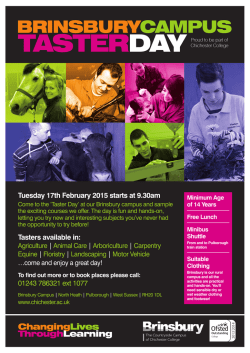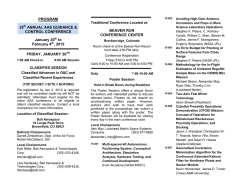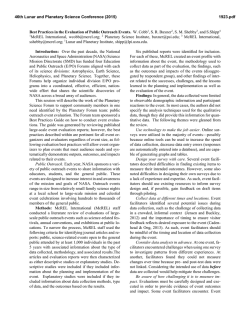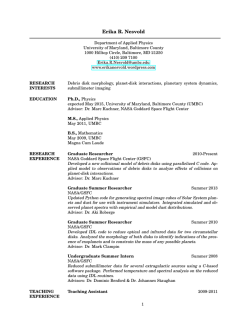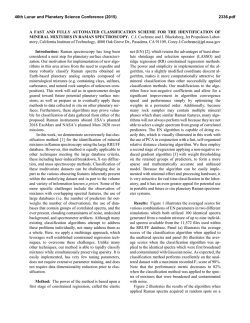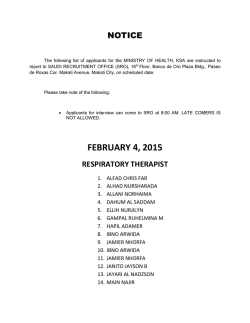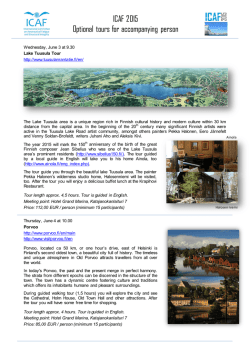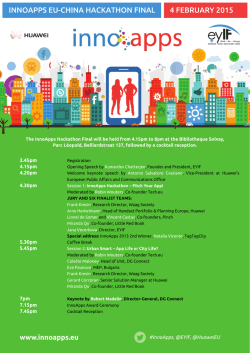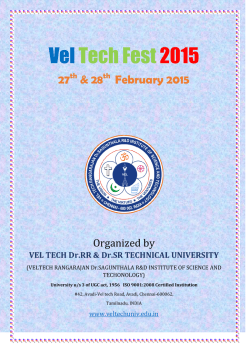
Session descriptions (pdf) – Friday
Friday Session Booklet 1 February 6, 2015 February, 7,2014 7:15am Check-in 8:00 Keynote– Future of Spaceflight Panel 10:00 Session 1 (90 min) 11:30 Lunch– O-g 12:45 Session 2 (90 min) 2:45 Session 3 (90 min) 4:45 Dismiss (Bus Run Begins) 7:15-11:45 Banquet (bus will make hotel loops) 8:00am-2:45pm JSC Innovation/ Exhibitors booths (Plaza) Session Selection Selecting your individual breakout sessions is easy! Just read through this conference booklet to see the selections for each time slot. Then, use the “Organize Your Sessions” form on page 10 to organize your sessions. Finally, go online and make your session selections at http://www.spacecenterprogs.org/ seec/seecLogin.aspx Sessions that are full will not appear. It’s that easy! Just be sure to move quickly as some sessions fill up fast. Breakout sessions include NASA tours as well as the hands-on sessions. Tours fill up especially fast, so please plan accordingly. (All tours require closed-toe shoes) If a session is full, don’t worry. Check with the Conference Help Table when you arrive to see if there are openings or watch the “swap” board for the session ticket. If you have any questions, please contact us by e-mail at [email protected]. 2 February, 6,2015 Johnson Space Center Tours: Mission Control Tour Once the manned spacecraft have launched, Houston Mission Control takes over. Visit this secure location and see the rooms where history happened. You will be able to see both Historic Mission Control and ISS Control rooms. Neutral Buoyancy Lab Take a trip to the largest pool in the world where astronauts practice for their spacewalks—the NBL. This facility is the underwater training facility for the astronauts and your chance to see state-of-the-art training—the next best thing to space! Follow us on Facebook https://www.facebook.com/groups/SEECATSCH/ Space Vehicle Mock-up Facility (SVMF) Explore the training grounds for the astronauts. See full size mock-ups of the Space Station and Orion. It also includes several other small part task trainers and mockups. IMPORTANT NOTICE!!! PLEASE READ CAREFULLY Your visit to the Johnson Space Center (JSC) is a special event. You will be entering working facilities subject to strict safety and security policies. Please follow the direction of your host escort at all times. It is essential that all members of the group stay together and not venture from their JSC escort. Wandering into restricted areas constitutes a security violation and could result in the termination of your visit. Your visit will require walking and standing for extended periods and may involve climbing several flights of stairs. Guests should wear comfortable, flat, fully-enclosed shoes (no high-heels, sandals, flip-flops, slides, mules, Crocs, etc.) during their visit. We also recommend that guests wear slacks (instead of shorts or skirts) as an additional safety precaution. Cameras are welcome in all facilities unless instructed otherwise. However, photography of individuals is discouraged without permission. ATTENTION ALL NON-U.S. CITIZENS If you are not a U.S. citizen, you must fill out a JSC Security Form in order to attend the NASA Tours. Please go to the SEEC website for more information and to download the form. http://spacecenter.org/education-programs/teacher-programs/teachers-seec/ 3 February, 6, 2015 10:00AM – 11:30AM Explorations Becoming a Spacewalker Daniel Loewen, Fresno County Office of Education, and Veronica Seyl, NASA JSC Aerospace Scholars Jerry Ross– Former Astronaut Bring Earth/Mars Activities, Experts, & Opportunities to Your Classroom Paige V. Graff and Suzanne Foxworth, Jacobs@NASA Johnson Space Center Join this hands-on, inquiry-based session and have fun with an Earth/Mars comparison activity. You will also learn how to get involved with NASA exploration right from your classroom, including requesting new imagery from astronauts on the ISS. We will also virtually connect with a Mars scientist! NASA resources/handouts provided. Grade Level: 6th-12th Subjects: Science Boeing Houston Product Support Center The Houston Product Support Center (HPSC) supports the assembly, integration, and testing of high reliability human space flight hardware end items. The tour includes an up close view of capabilities such as soft good manufacture (i.e. “space blankets”), electronic design & manufacture, and light machining and sheet metal fabrication, as well as external views of the CST-100 mock up and docking systems. From the Wright brothers to NASA, wind tunnels have been used to forward aerospace exploration. Discover NASA’s current wind tunnel research. Test and build models of standing structures, aircraft, spacecraft, and land forms. Explore how this hands-on modality can enrich and bring realworld relevance to your math and science instruction. Audience: 6th-12th Subjects: Science, Tech, and Math FABulous Reading with Hands-on Science Holly Mentillo, Ocean Breeze ES/NEAT, and Betty Bigney, Dixon ES/NEAT This FABulous session is intended for K-2 teachers. We will integrate reading and songs with hands-on science to help young students better understand science concepts. Attendees will be given questions for the books, do the handson lessons and be given strategies to help implement both into the instructional day. Grade Level: K-2nd Subjects: Science and Language Arts Hands-On Engineering Using the Engineering Design Process Limited to U.S. citizens only. Government-issued photo ID is required for badging. You will be entering a production facility subject to strict safety & security policies. All visitors will be escorted by a Boeing employee at all times. Visitors MUST wear comfortable, flat, fully-enclosed shoes (no high-heels, sandals, flip-flops, slides, mules, Crocs, etc.) during their visit. We also recommend that guests wear slacks (instead of shorts or skirts) as an additional safety precaution. No cameras or camera enabled devices allowed on tour. Mitzi Herring and Janice Katz, Davenport School of the Arts Eat, Exercise, Feel, and Maybe Dream of Becoming an Astronaut! Dorinda Risenhoover and Chelsey Mawson, NASA Oklahoma Space Grant Consortium Craig Wilson, Ph.D., NSBRI TAP/Texas A&M/USDA Are you wanting to empower your students in STEM with robotics, but your supply budget doesn’t allow for the purchase of a classroom set of kits? Never fear! We will immerse you in 4 CHEAP hands-on STEM-based robotic activities which will help your students better understand how a robotic arm end effector works! Hands-on activities to let your students take (space) flight. Try out experiments that will allow your students to collect data to study the importance of exercise for astronauts to maintain their musculoskeletal system in micro-gravity. Study and experience spatial disorientation. Taste astronauts’ favorite food and calculate its calorific value… th Grade Level: K-12 Subjects: Science, Math, Tech, and Physical Education & Health 4 Join in on a hands-on engineering session utilizing the Engineering Design Process. Learn how using the EDP helps students build innovative and creative thinking styles and enhances their science and engineering knowledge and confidence. Adaptable to all grade levels. Leave ready to implement in your classroom or club! Grade Level: K-5th Subjects: Science, Math, and Language Arts Hands-On Robotics on a Dime Grade Level: 3rd-8th Subjects: Science, Math, and Tech February, 6,2015 Journey to Mars: NASA Resources for the Informal Educator Patricia Moore, NASA Johnson Space Center NASA Engineering in the Middle School Classroom: Introduction to Engineering Design: Water Filtration Challenge Attention informal educators! Are you and your institution searching for the most current and museum-friendly NASA resources? Join NASA as we explore NASA’s Journey to Mars and the transportation systems that will get us there by the 2030s. Session participants will gain an understanding of the future of deep space human spaceflight, receive a digital Journey to Mars Museum Kit, and participate in a roundtable discussion to determine how NASA may better support museums, science centers, Challenge Learning Centers, and planetariums in the future. *This session is geared toward informal educators, but all are invited.* Angelo Casaburri, NASA Educator Professional Development Project Grade Level: K-12th Subjects: Science and Tech Grade Level: 6th-12th Subjects: Science & Math Launching Readers into Space Pumps Your Blood: Effects of Space Flight on the Cardiovascular System Jennifer Becerra & Rick Varner, Scobee Education Center/ Challenger Learning Center at San Antonio College Stephen Wagner, Stephen F. Austin State University Connect science and literature through children’s books. This session will integrate literature into your science curriculum. We will explore hands-on activities that collaborate with earth and space content in children’s books. Come explore! Earn your chance to get your very own books to begin incorporating into your science lesson plans. Grade Level: K-8th Subjects: Science, Tech, Language Arts, Physical Education & Health, Fine Arts, Social Studies, History Mousetronaut in Space! Sharon Young and Sue Hare, iSPACE Launch STEM-literacy connections with Mousetronaut and Mousetronaut Goes to Mars, written by Commander Mark Kelly. Be inspired by hands-on activities for grades K-5 that include M.A.R.S. (Mouse Astronaut Recovery System, i.e., parachutes), geology, and health. These lesson plans will relate to issues on Earth as well as sending explorers (both mouse and mankind) to space and back. Door prizes include a copy of each book! Grade Level: K-5th Subjects: Science, Math, Tech, Physical Education & Health, Language Arts, and History Incorporate engineering design as a problem solving method and cross-cutting concept in the classroom using NASA STEM resources. Participants will be led through the steps of the engineering design cycle using the Engineering Design Challenge: Water Filtration. Design a water filtration device that will yield the purest water using only the consumable materials provided. Participants will build and test two water filtration design cycles. Additional NASA engineering design resources, including videos, educator guides and lesson plans are included. In March 2015, astronaut Scott Kelly will embark on a one-year mission on the International Space Station to study the effects of long-duration spaceflight on humans! Learn how to engage your student’s in this historic mission with hands-on, groundbased studies of the body that focus on the cardiovascular system. Grade Level: 6th-12th Subjects: Science, Math, Tech, and Physical Education & Health Rich Mathematical Problems and Flipping the Classroom Sandra Miller, Lamar High School, and Stephanie Smith, Euless Junior High School Astronomy offers a great source of material to a Geometry or Algebra 2 teacher, so that students practice math by solving interesting problems, such as the distance to the horizon on Mars. To make time for these problems, we will also discuss strategies for “flipping” the classroom instruction. Grade Level: 9th-12th Subjects: Math Space Launch System: NASA’s Next Great Ship Twila Schneider and Shannon Raleigh, NASA Marshall Space Flight Center The Space Launch System is NASA’s next great ship! Come learn about this exciting part of NASA’s Journey to Mars and build your own launch platform. Hand-outs provided. Grade Level: 3rd-5th Subjects: Science, Math, and Tech Tours: 5 Space Vehicle Mock-up Facility (SVMF) Mission Control Tour Neutral Buoyancy Laboratory Space Center Houston’s 747/ Shuttle February, 6,2015 12:45PM – 2:15PM A Little Bit of Space First Nation Tools in Space Michael Wilkinson, Fieldston Lower School and Erin Mulcahy, littleBits Elizabeth Proulx and Sophie Lussier, Lester B. Pearson School Board The newly released littleBits NASA kit supports the exploration of Earth and Space science and the electromagnetic spectrum. Join us in this workshop to experience the play and exploration that makes STEAM fun. Activities include Energy Sensing, Orbits, Wave Propagation and Behaviors, Stars, Long Distance Communications, Planetary Exploration, and Rover Races. Come discover how first nation tools and artifacts from the 16th century will inspire you to create robots to help you live on Mars. You will explore the assets and limitations of the territory and analyze the evolution of the International Space Station to guide you in the creation of your Lego WeDo prototype. rd Grade Level: 3 -12 th Grade Level: 3rd-5th Subjects: Science, Tech, Language Arts, Social Studies, and History Basic Robotics in a Budget Javier Montiel and David Garcia, Brazosport ISD, Monterrey Institute of Technology Robotics enthusiasts! Learn the basics of robotics with kinesthetic group dynamics that will explain complex robotics tasks. Learn how to design student challenges using teacher budget friendly robots for your students. Get some door prices and start up your robotic adventure. Grade Level: K-12th Subjects: Science, Math, and Technology Connecting Classroom Technology to the Real World Stacey Welch and Kayla Lechler, NASA JSC – Office of Education In today’s technology-driven world, students need opportunities to develop their tech-savvy. This presentation focuses on integrating 3D-printing, iPads, iMovie, etc. into the classroom and helping students understand connections between mastering these skills in school and applying them in the real world. Funding ideas for new technology will also be given. Grade Level: 9th-12th Exploration and Art Together – Yes! Paige V. Graff and Suzanne Foxworth, Jacobs Technology at NASA Johnson Space Center In this NASA Vision of Discovery Workshop, educators will follow the steps of exploring new planets and they will become artists for a cosmic connection. This is a hands-on workshop where you will learn to engage your class in exploration. Come prepared to participate! Intergalactic War: Third World War? Carmen Pallotta, Marie-Eve Frenette, Manon Bournival, and Candice Adams, Lester B. Pearson School Board In this interactive and hands-on session, the participants will learn how to integrate a variety of subjects ranging from language arts to mathematics while using the NXT robotics kits. Come and discover the progression of the first catapult until today. Teachers will experience the engineering process within the robotic space mission, reinvesting the information gathered relating to the history of the catapult to help them develop a new and improved design. Come and discover the power of the NXT robotic as a teaching tool. Grade Level: 6th-8th Subjects: Science, Math, Tech, Language Arts, Fine Arts, Social Studies, History Light up the Sky! Dee Mock, Houston ISD, Christine Graham, McKinney ISD and Jason Dedrick, Houston ISD Do STEM challenges ignite excitement and interest in science, technology, engineering and math? You bet they do! Join us as we take you through several STEM design challenges. Your students will learn to think like a NASA engineer as they design, create, test and redesign an electrical card. Your students will “Light up the Sky” with their amazing designs. Walk away with several exciting design challenges that include a do it yourself design kit. Audience: 3rd-5th Subjects: Science, Math, Tech, Language Arts, and Fine Arts Grade Level: K-12th Subjects: Science, Tech, Math, Language Arts, and Fine Arts 6 February, 6,2015 NASA Engineering in the High School Classroom: Introduction to Engineering Design: Water Filtration Challenge Sense-sational Space Station Angelo Casaburri, NASA Educator Professional Development Project When astronauts go to space, senses don’t function as on Earth. Using senses to make scientific observations becomes more important when one sense doesn’t work. Can you imagine assembling nuts and bolts on the ISS without an effective sense of touch? Activities and tools are introduced that accommodate an altered sense. Incorporate engineering design as a problem solving method and cross-cutting concept in the classroom using NASA STEM resources. Participants will be led through the steps of the engineering design cycle using the Engineering Design Challenge: Water Filtration. Design a water filtration device that will yield the purest water using only the consumable materials provided. Participants will build and test two water filtration design cycles. Additional NASA engineering design resources, including videos, educator guides and lesson plans are included. Grade Level: 9th-12th Subjects: Science & Math Presenting the International Space Station in K-12 Dr. Gary H. Kitmacher, NASA International Space Stations Office Dr. Kitmacher has been associated with the International Space Stations since its inception and was responsible for designing several major elements of the ISS such as the Cupola, the US Lab Module and the logistics provisions for supplying astronaut supplies. Dr. Kitmacher has also been involved in the development of classroom curriculum for presenting spaceflight and the ISS. Some of these materials will be distributed at the SEEC session. Grade Level: K-12 Subjects: Science, Technology, Language Arts, Math, Fine Arts, Social Studies, History Kathy Zubelik, iSPACE Grade Level: K-2nd Subjects: Science, Math, Tech, and Language Arts Space Suits in the Classroom Greg Kennedy, NASTAR Center No space suit? No problem! This workshop demonstrates ways to show students how space suits operate using balloons, gloves, and other readily available materials. Attendees also learn about the fascinating history of space suits. Grade Level: 3rd-8th Subjects: Science and Tech Soar with Space Racers Elaine Lapka, NASA JSC Educator Resource Center Become a fan of Headmaster Crane and his five eager cadets as they learn about science, space, and teamwork. NASA serves as technical advisor for science accuracy in this PreK-2 PBS animated series. We’ll sample the accompanying hands-on explorations and experiments with solar system, aeronautics, and physics topics. Can you meet this preschool challenge? Grades: PreK-2 Subjects: STEM Start Your Own Space Program Products of Student Learning Laura Teatsworth, Charlotte West, and Nikki Skinner, Houston ISD This is a short course on foldables for primary/elementary grades. We will show you how to put the WOW! factor back into your students’ lesson products, giving them a creative outlook while allowing students to become proud of their work! We’ll show you how to make a ROCKET out of a basic envelope, and an astronaut, too! You’ll make a “moon phases” motivator, using only a black circle and scissors! Join The Teachers on the Loose and escalate student learning! Grade Level: K-5th Subjects: Science, Language Arts, and Fine Arts Brian Krauklis and Stacey Levin, Katy ISD Looking for the ultimate hands-on experience for your students? Send them to another planet! We’ll show you all you need to set up a space program in your school, including how to build a classroom size (or larger) spacecraft and activities for your mission. Our program can easily be adapted so any teacher can create an experience their students will always remember! Grade Level: 3rd-12th Subjects: Science, Tech, Math, Physical Education & Health, Language Arts, Social Studies, and History Tours: Mission Control Tour Neutral Buoyancy Lab SAIL Tour 7 February, 6,2015 2:45PM – 4:15PM Advance Imagine Rockets Chris Welborn, Pima Air & Space Museum and Nora Rankin Pima Air & Space Museum Come join us for a class using rockets to explore the concepts of mass, inertia, stability, gravity, laws of motion, and chemistry. Make and use a variety of small rockets to demonstrate these principles. Experience a simulated Mars landing and gather samples with your own Mars Rover. Each attendee with make several simple low powered rockets to take home. Field Trip to the Moon! Jennifer Hudgins and Lynn Dotson, NASA Educator Resource Center at Kennedy Space Center The Field Trip to the Moon program uses an inquiry-based learning approach that fosters team-building and introduces students to careers in science and engineering. You will come face-to-face with the challenges and excitement of launching from Earth’s surface and journeying through space to land on the Moon. You will also discover what makes our planet unique and habitable. Cool NASA door prizes will also be given away! Grade Level: 3rd-12th Subjects: Science, Technology, Math Grade Level: 6th-12th Subjects: Science, Tech, Math, Language Arts, Physical Education and Health, Social Studies, and History Aerospace Connections in Education: Be an ACE Teacher! LIGHT Circus Angie St. John and Ginny Smith, Civil Air Patrol Take learning to new heights with Civil Air Patrol’s free, interdisciplinary Aerospace Connections in Education (ACE) Program for grades K-6! You’ll receive 9 aerospace lesson plans, a set of solar system cards, and you’ll learn how to connect aerospace to your grade’s curriculum. We’ll play Solar System Survivor and make flying Fun Shuttles and Geobats! Door prizes! Grade Level: K-8th Subjects: Science, Math, Technology, Physical Education & Health, Language Arts, Social Studies, and History Kathleen “Kat” Mills, NEAT, and Megan Woodring, Aerospace Engineer Why are stars different colors? Confused about electromagnetic waves and their origins? Need help distinguishing between the particle and wave theories of light? Dispel student misconceptions about light and color using fun, hands-on activities about elements, energy, and their everyday applications. Free CD and equipment giveaway. Grade Level: 6th-12th Subjects: Science and Tech Electromagnetism Experimentations and the MMS mission Pre-Service Teachers at NASA Come Learn about NASA’s Nes MMS mission through hands on demonstration and experimentation about magnets, Electromagnet, and induction. Session will include information about CME’s, New MMS spacecraft mission, and how this mission can be taught to students. In this session, participants will discover how NASA prepares pre-service teachers to teach space science. Information about the NASA Pre-Service Teacher Institute will be provided and hands-on activities from the program will be conducted. This session is open to all K-12 educators. Kelly Bird, Rice MST Graduate Student and Physics and Dr. Patricia Reiff Grade level: 6-12 Subjects: Science, Math, Technology Suzanne Foxworth and Maria Chambers, NASA Johnson Space Center SEA Team Grade Level: K-8th Subjects: Science, Tech, and Math Engineer the Perfect Shipping Package and “Ship the Chip” Linda Drobnich, San Jacinto College Learn about how engineers supporting the International Space Station (ISS) plan, coordinate, and package standardized containers for cargo delivery to and from the ISS. Apply those engineering product packaging, planning, and design principles like a NASA engineer, and explore the Ship the Chip hands-on exercise with your middle school students. Grade Level: 6th-8th Subjects: Science and Math Science Misconceptions in Our Class: Correct Them, Don’t Teach Them Robert S. Radnich, Meadville Area Senior High, and Harry G. LaForge Jr., Hoffman Pilot Center Science misconceptions are everywhere. How do we stop them from coming into, or even worse, leaving our classroom? Learn about common science misconceptions and how to teach the correct science. Learn how to use demonstrations and activities in your class. Learn how to find out about science misconceptions. Grade Level: 3rd-12th Subjects: Science and Tech 8 February 6,2015 Texas: The Space State Edward Wright and Michael Johnson, Citizens in Space Texas is becoming a leader in the emerging commercial space industry. Learn about the new spaceports, business ventures, and research projects springing up in the Lone Star State, and how you can connect to your STEM programs. Grade Level: K-12th Subjects: Science and Tech The Microbe Menace: Engaging Students in Authentic Space-Based Research Angela Krause-Kuchta, Orion’s Quest, NEAT, MHS, and Thomas Drummond, Orion’s Quest Microbial virulence has been shown to increase in space. At the same time, the immune systems of astronauts become compromised. Learn about ground-breaking NASA research on ISS that pairs these two situations and engage your students in analyzing down-linked video, collecting and recording data, and evaluating results. Grade Level: 6th-8th Subjects: Science and Math There’s More to Light than Meets the Eye Bev Ketron and Jean Bolte, iSPACE Join in the fun as we shed “light” on the science of light! Discover the critical role light plays in space exploration, investigate properties of light and the electromagnetic spectrum with engaging activities, “see and hear” evidence of light beyond the visible spectrum, “make and take” a spectroscope, and more. Includes lessons and a door prize. Grade Level: K-8th Subjects: Science, Math, Tech, and History Using My NASA Data to Explore Earth Systems Lynne Hehr, Arkansas NASA ERC & the STEM Center for Math & Science Ed, and John G. Hehr, University of Arkansas Department of Geosciences Using My NASA DATA and GLOBE’s Digital Earth System (poster 1) explore the concepts of Earth as a System, (2) find patterns/connections between and among maps containing different environmental data and, (3) explore the relationship between time and space in regard to global environmental data. Loads of materials provided. Grade Level: 9th-12th Subjects: Science, Math, and Tech 9 February 6,2015 10:00AM – 11:30AM A Little Bit of NASA Fun Art and the Cosmic Connection Basic Robotics in a Budget Boldly Go Where Few Teachers Have Gone Build an ISS Engineering 101: Designing a Rover Engineering for Middle School Houston: We Are Go for Exploration Inspiring our Students Through Technology: Kindernauts NanoRacks LLC, Houston Facility Tour Science on Flying, Falling, Spinning, Twirling Speed Dating with the Digital Learning Network Tours: Space Vehicle Mock-up Facility (SVMF) Robotics Lab Tour Food Lab Tour Precision Air Bearing Floor (PABF) 12:45PM – 2:15PM Alien Genetics- Have You Been Contacted? Be A Space Engineer. LEGO Bricks in Space! 10 Voyage from Home; Cook up a Comet Wings, Strings, and Flying things Tours: Mission Control Tour Neutral Buoyancy Lab SAIL Tour 2:45PM – 4:15PM Affordable Astrophotography in Schools Areology and Remote Sensing on Mars Folding Your Way to Success The Great Connection Living and Working Together on the ISS! Everything but the Kitchen Sink! Teaching the Civil Air Patrol ACE Program Mars: The Planet That Once Was & Is Missions to Discovery Mission Solar System with the EDP! Real Students Meet Real Research (The ISS Way!) Satellites from Start to Finish the Fun Way! To the Moon and Back What's the Matter U-Mass, Matter, Space, and So Much More Cause, Effect, Cause, Effect, Cause, Effect: POP! Citizen Science and Citizen Space Exploration Tours: Climate Classification and Climate Change Exploration Then and Now How to Make a Microgravity Drop Tower for your Classroom Session) Imagine Rockets. Creating Lessons for iDevices Scientists by Modeling Scientific Practices (Double Angry Bird Physics Before Return to the Moon in your Classroom! Transforming Students into Earth/Planetary Mass & Earth & Playing Pro Baseball…on Pluto Space Vehicle Mock-up Facility (SVMF) Robotics Lab Tour Food Lab Tour Precision Air Bearing Floor (PABF) Objects In The Sky Our Eyes in Space: Revealing Black Holes Quadrilaterals in Space February, 7,2014
© Copyright 2025
